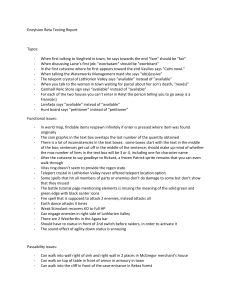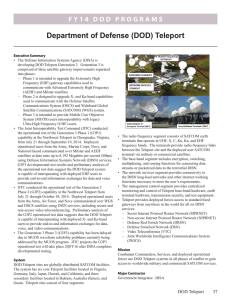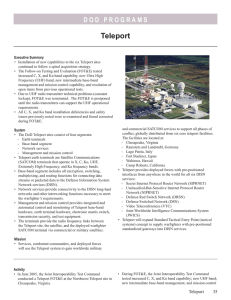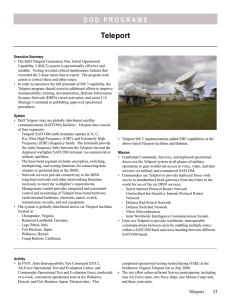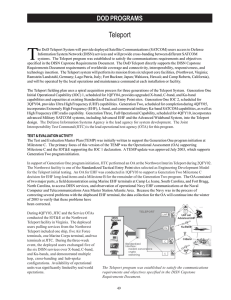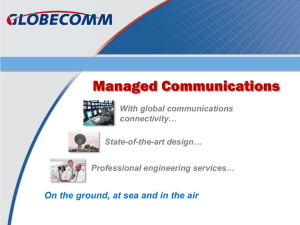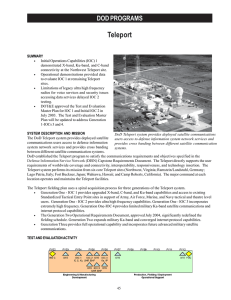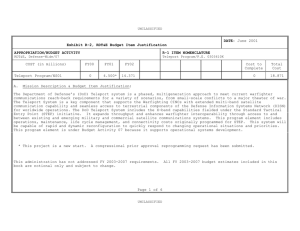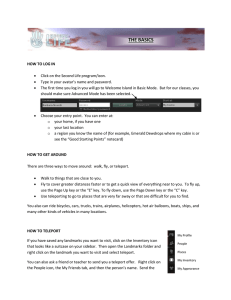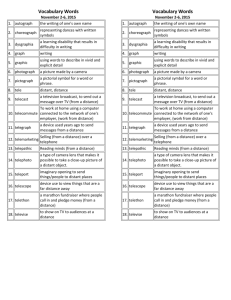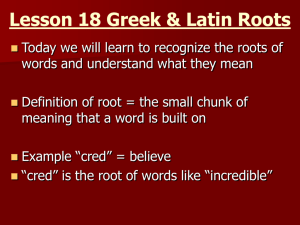Department of Defense (DOD) Teleport
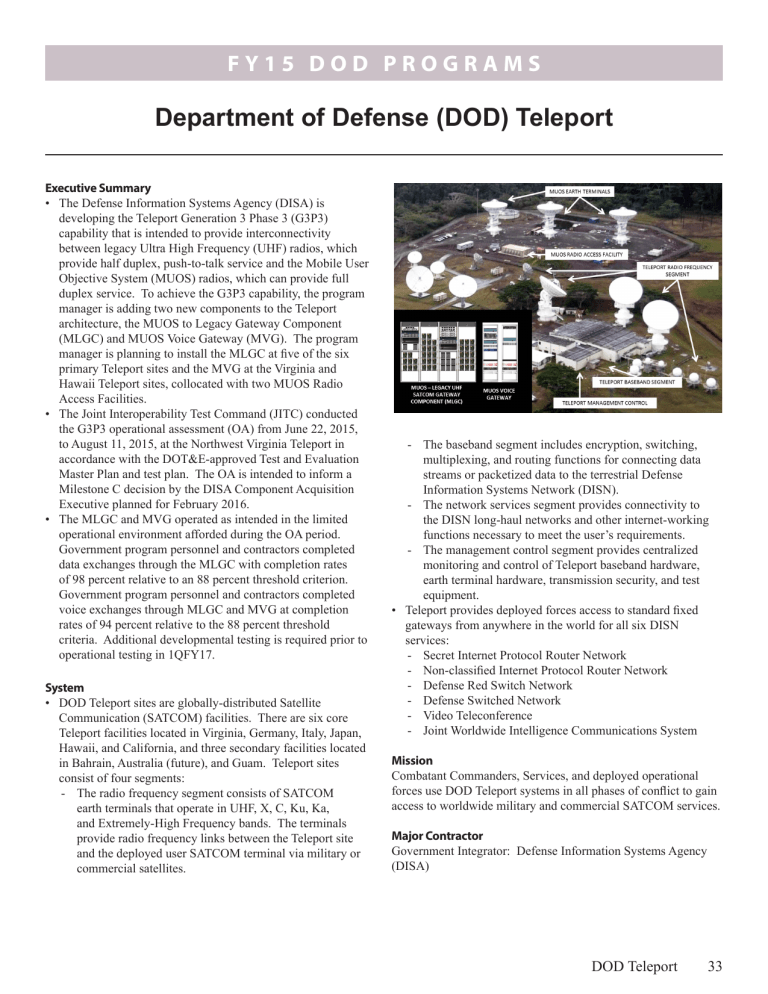
F Y 1 5 D O D P R O G R A M S
Department of Defense (DOD) Teleport
Executive Summary
• The Defense Information Systems Agency (DISA) is developing the Teleport Generation 3 Phase 3 (G3P3) capability that is intended to provide interconnectivity between legacy Ultra High Frequency (UHF) radios, which provide half duplex, push-to-talk service and the Mobile User
Objective System (MUOS) radios, which can provide full duplex service. To achieve the G3P3 capability, the program manager is adding two new components to the Teleport architecture, the MUOS to Legacy Gateway Component
(MLGC) and MUOS Voice Gateway (MVG). The program manager is planning to install the MLGC at five of the six primary Teleport sites and the MVG at the Virginia and
Hawaii Teleport sites, collocated with two MUOS Radio
Access Facilities.
• The Joint Interoperability Test Command (JITC) conducted the G3P3 operational assessment (OA) from June 22, 2015, to August 11, 2015, at the Northwest Virginia Teleport in accordance with the DOT&E-approved Test and Evaluation
Master Plan and test plan. The OA is intended to inform a
Milestone C decision by the DISA Component Acquisition
Executive planned for February 2016.
• The MLGC and MVG operated as intended in the limited operational environment afforded during the OA period.
Government program personnel and contractors completed data exchanges through the MLGC with completion rates of 98 percent relative to an 88 percent threshold criterion.
Government program personnel and contractors completed voice exchanges through MLGC and MVG at completion rates of 94 percent relative to the 88 percent threshold criteria. Additional developmental testing is required prior to operational testing in 1QFY17.
System
• DOD Teleport sites are globally-distributed Satellite
Communication (SATCOM) facilities. There are six core
Teleport facilities located in Virginia, Germany, Italy, Japan,
Hawaii, and California, and three secondary facilities located in Bahrain, Australia (future), and Guam. Teleport sites consist of four segments:
- The radio frequency segment consists of SATCOM earth terminals that operate in UHF, X, C, Ku, Ka, and Extremely-High Frequency bands. The terminals provide radio frequency links between the Teleport site and the deployed user SATCOM terminal via military or commercial satellites.
- The baseband segment includes encryption, switching, multiplexing, and routing functions for connecting data streams or packetized data to the terrestrial Defense
Information Systems Network (DISN).
- The network services segment provides connectivity to the DISN long-haul networks and other internet-working functions necessary to meet the user’s requirements.
- The management control segment provides centralized monitoring and control of Teleport baseband hardware, earth terminal hardware, transmission security, and test equipment.
• Teleport provides deployed forces access to standard fixed gateways from anywhere in the world for all six DISN services:
- Secret Internet Protocol Router Network
- Non-classified Internet Protocol Router Network
- Defense Red Switch Network
- Defense Switched Network
- Video Teleconference
- Joint Worldwide Intelligence Communications System
Mission
Combatant Commanders, Services, and deployed operational forces use DOD Teleport systems in all phases of conflict to gain access to worldwide military and commercial SATCOM services.
Major Contractor
Government Integrator: Defense Information Systems Agency
(DISA)
DOD Teleport 33
F Y 1 5 D O D P R O G R A M S
Activity
• DISA is developing the Teleport G3P3 capability that is intended to provide interconnectivity between legacy UHF radios, which provide half duplex, push-to-talk service and
MUOS radios, which have the capability to provide full duplex service. To achieve the G3P3 capability, the program manager is adding two new components to the Teleport architecture, the MLGC and MVG. The program manager is planning to install the MLGC at five of the six primary
Teleport sites and the MVG at the Virginia and Hawaii
Teleport sites, collocated with two MUOS Radio Access
Facilities.
• In March 2015, DISA installed a MLGC test suite at the
DOD Teleport Test Lab within the Army’s Joint Satellite
Engineering Center, at Aberdeen Proving Ground, Maryland, and at the Northwest Virginia Teleport site for integrated testing.
• JITC conducted the G3P3 OA from June 22, 2015, through
August 11, 2015, at the Northwest Virginia Teleport in accordance with the DOT&E-approved Test and Evaluation
Master Plan and test plan. The OA informs a Milestone C decision by the DISA Component Acquisition Executive planned for February 2016.
- JITC testers observed set-up, management, and tear-down of services at the DOD Northwest Virginia Teleport, and communication between deployed users at Saint
Julien’s Creek, Virginia, and the MUOS Radio Integration
Laboratory in San Diego, California. Operators using two legacy UHF radios and two MUOS-capable terminals located at Saint Julien’s Creek exchanged data and voice with two MUOS-capable terminals located at the MUOS
Radio Integration Laboratory. Contractor and government subject matter experts configured the Teleport equipment and operated the deployed radios.
Operational testers collected equipment uptime and downtime to support an assessment of reliability and availability.
- In conjunction with the OA, JITC conducted a cooperative cybersecurity assessment from September 28, 2015, through October 2, 2015, at the Northwest Virginia
Teleport site.
• DOT&E submitted the DOD Teleport System, G3P3
Operational Assessment in December 2015.
• JITC plans to conduct an operational test of the G3P3 capability in 1QFY17.
Assessment
• The OA provided a limited operational environment. The
MLGC and MVG test suites installed at the Northwest
Teleport were configured and operated by contractor personnel. Teleport operators were not contractually allowed to configure the MLGC or MVG prior to government acceptance of the equipment.
• The MLGC and MVG operated as intended in the limited operational environment afforded during this test period.
Government program personnel and contractors completed data exchanges through the MLGC with completion rates of 98 percent relative to an 88 percent threshold criterion.
Government program personnel and contractors completed voice exchanges through MLGC and MVG at completion rates of 94 percent relative to the 88 percent threshold criteria.
• The JITC cooperative cybersecurity assessment identified potential vulnerabilities that could degrade system security.
• Although the MLGC and MVG performed well, the limited data from this test precludes the MLGC and MVG meeting reliability and availability requirements with confidence.
Based upon the scope of the OA testers were not able to evaluate maintainability and documentation.
• The Teleport Test and Evaluation Master Plan needs to be updated to support the G3P3 Milestone C decision planned for
February 2016 and support the G3P3 operational test planned for 1QFY17.
Recommendations
• Status of Previous Recommendations. DISA has satisfactorily addressed all previous recommendations.
• FY15 Recommendation.
1. DISA should update the Teleport Test and Evaluation
Master Plan before the G3P3 Milestone C decision planned for 2QFY16 and the G3P3 operational test planned for
1QFY17.
